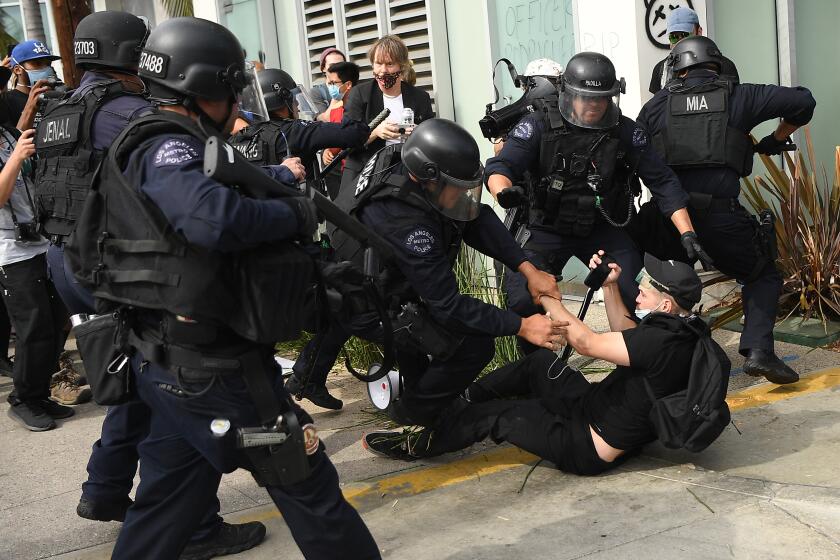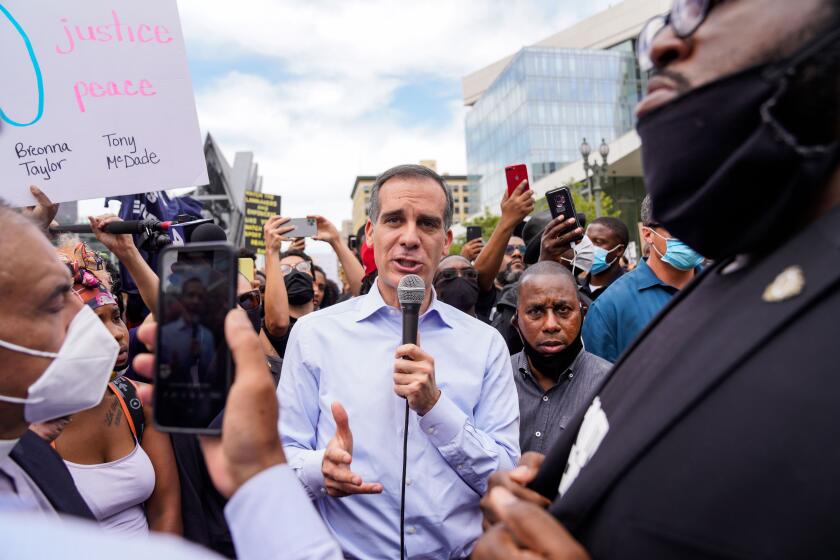LAPD violence against George Floyd protests erodes a decade of reforms
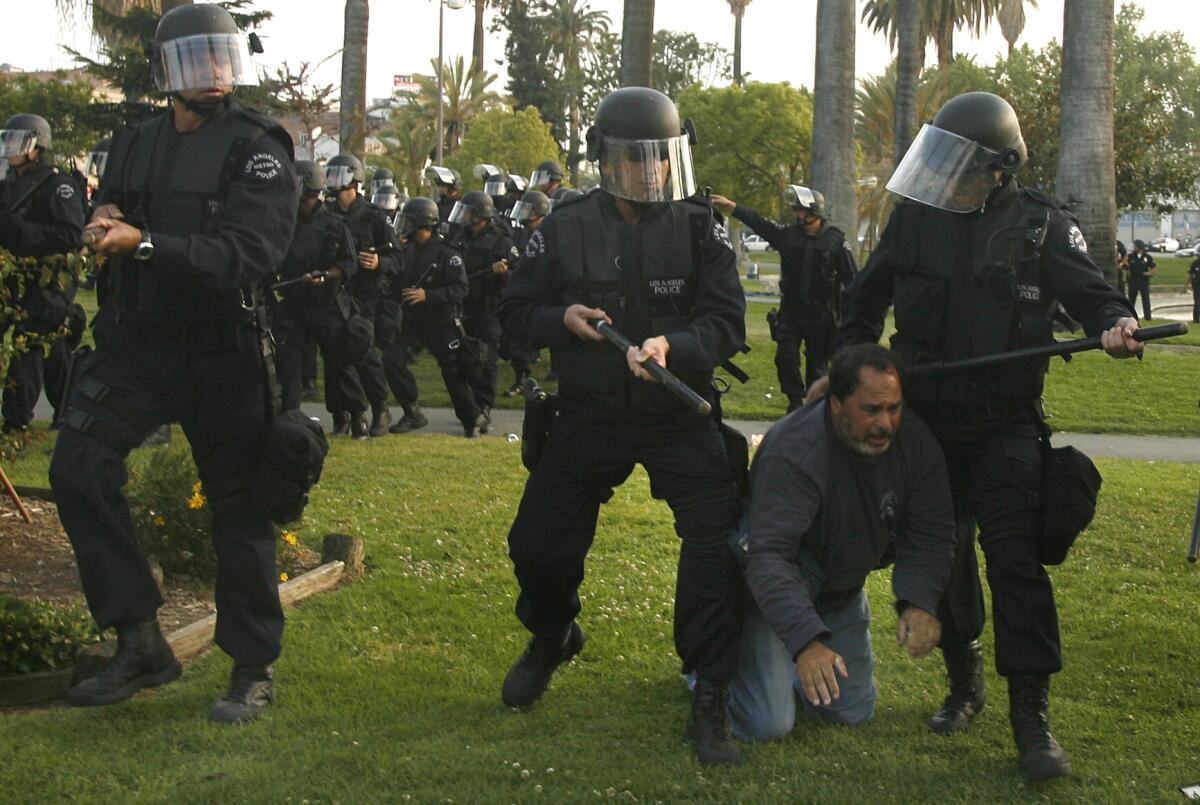
- Share via
May Day, 2007, began peacefully in Los Angeles. It ended as another dark, violent chapter for the city’s Police Department.
As annual immigrant rights demonstrations wound down, marchers gathered at MacArthur Park. When a small group of agitators threw bottles and other objects, disorganized police responded with shocking force on the entire crowd. Officers in riot gear swept through the park, firing hard projectiles and beating people. The ruthlessness — televised live — left nearly 250 protesters injured. The city was outraged.
For a department still trying to reform itself after the Rodney King beating, the moment marked a giant step backward. The city ended up paying out more than $30 million to those hurt and once again agreed to changes designed to prevent such violence from happening again.
“What happened was wrong,” said the mayor at the time, Antonio Villaraigosa. “The inadequate planning, the breakdown in command and control, misuse of tactics created a cascading chain of escalating misjudgments.”
In the years that followed, as large demonstrations and marches went off without major upheaval, the LAPD’s reputation for brutality gave way to imperfect but undeniable progress. Allegations of heavy-handed police tactics at protests still sometimes arose, but the department appeared to have put itself on a new path.
Then came the killing last month of George Floyd by a police officer in Minneapolis and the mass protests that erupted in its wake. In Los Angeles, videos and accounts of officers again beating back seemingly peaceful protesters with batons and injuring others with “less lethal” projectiles returned the city back to 2007.
The police response has left Mayor Eric Garcetti, who was a member of the City Council when the MacArthur Park debacle occurred, and police leaders on the defensive as they face hard questions about whether the LAPD should have been better prepared and could have responded in a way that eased tensions instead of ratcheting them up.
Police in Los Angeles and other cities have fired 40-millimeter foam bullets at George Floyd protesters, drawing complaints of excessive force.
It remains to be seen whether the heavy-handed response the LAPD brought to the first days of the rolling protests was an anomaly or a reflection of a police force that has strayed from its course.
Top LAPD officials say they wanted to stick to its hands-off approach, but were forced to respond aggressively when large numbers of violent protesters targeted them with bottles and other projectiles.
Longtime critics of the department, however, see the protests as a major setback for the department.
“Will we ever reach a point where we consistently move forward and not a few steps forward and then 10 steps back?” said Carol Sobel, a longtime civil rights attorney who has won several large lawsuits against the LAPD over its handling of protests and is helping to sue it again now. “And this is at least 10 steps back, if not more.”
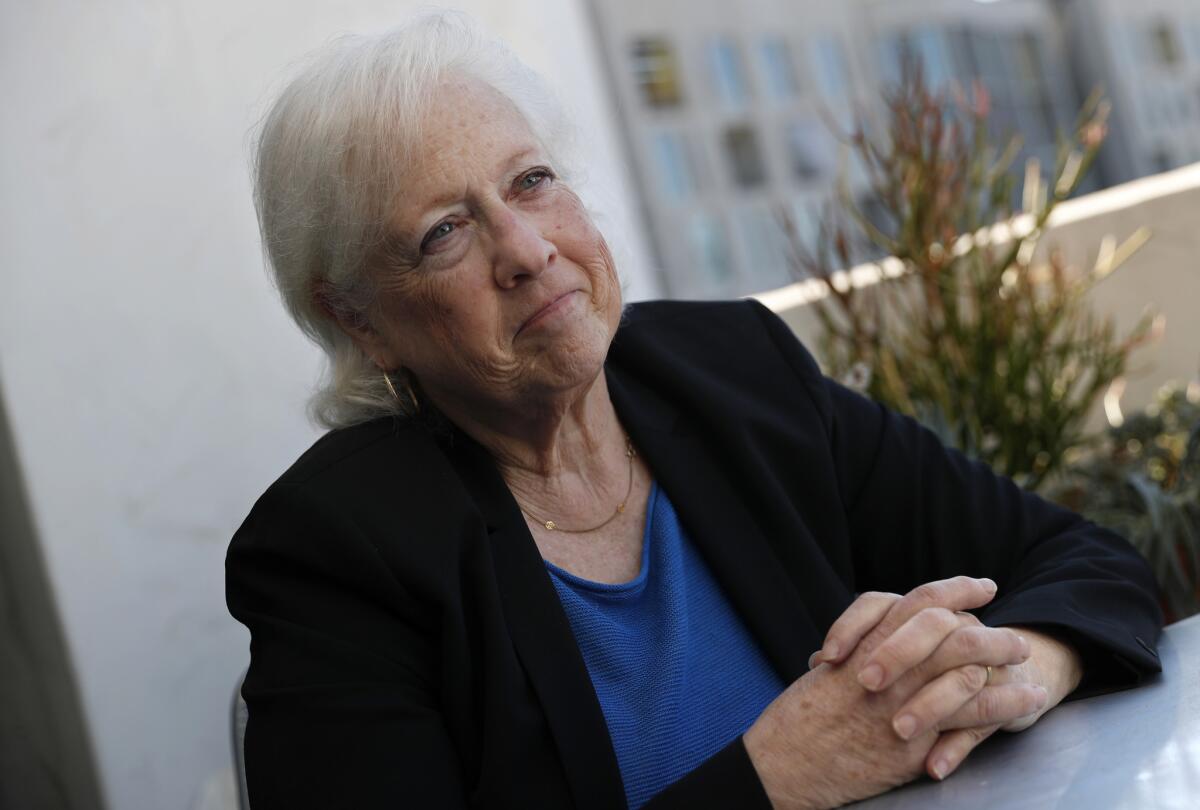
For decades, hardline tactics were the norm for the LAPD when officers and protesters met in the streets. The 1960s and 1970s are full of episodes in which a police force that proudly modeled itself after military organizations left people bloodied and dead.
Low points include the police response to the Watts riots in 1965, the violent dispersal of an antiwar protest in Century City against President Lyndon Johnson, and a 1987 protest in support of gay rights, in which Sobel recalled officers on horseback and on foot left demonstrators with head injuries and broken eye sockets.
The police mishandling of the 1992 acquittal of LAPD officers charged in the Rodney King beating was perhaps the darkest moment of the department’s recent past.
Unprepared and poorly trained officers were quickly overwhelmed by the uprising, which ended with thousands injured and 53 people dead, including 10 killed by police. Soldiers were sent in to end the upheaval.
After police forcibly broke up protests outside the 2000 Democratic convention using tear gas, pepper spray and rubber bullets, the city ended up paying more than $4 million in legal settlements, and the department agreed to a sweeping series of restrictions on how officers deal with large crowds.
The deal appeared to lead to improvements as department officials worked more closely with march organizers to avoid clashes. The strategy was on display in 2006 when hundreds of thousands of marchers descended on downtown L.A. for a pro-immigration rally.
But the goodwill was short-lived.
At the same immigration demonstrations the next year, a specialized unit of officers, rattled by a group of agitators, marched through MacArthur Park in L.A.’s Westlake neighborhood, injuring nearly 250 protesters and journalists with hard foam bullets and batons.
LAPD Chief Bill Bratton, who had spent years trying to build and repair ties between the department and minority communities, was livid.
On his order, aides produced a scathing report that found commanders had failed to adequately plan for the rally, issued confusing and sometimes contradictory orders and failed to control officers. And the officers, the report concluded, misused their weapons in ways that violated LAPD policies and basic training guidelines.
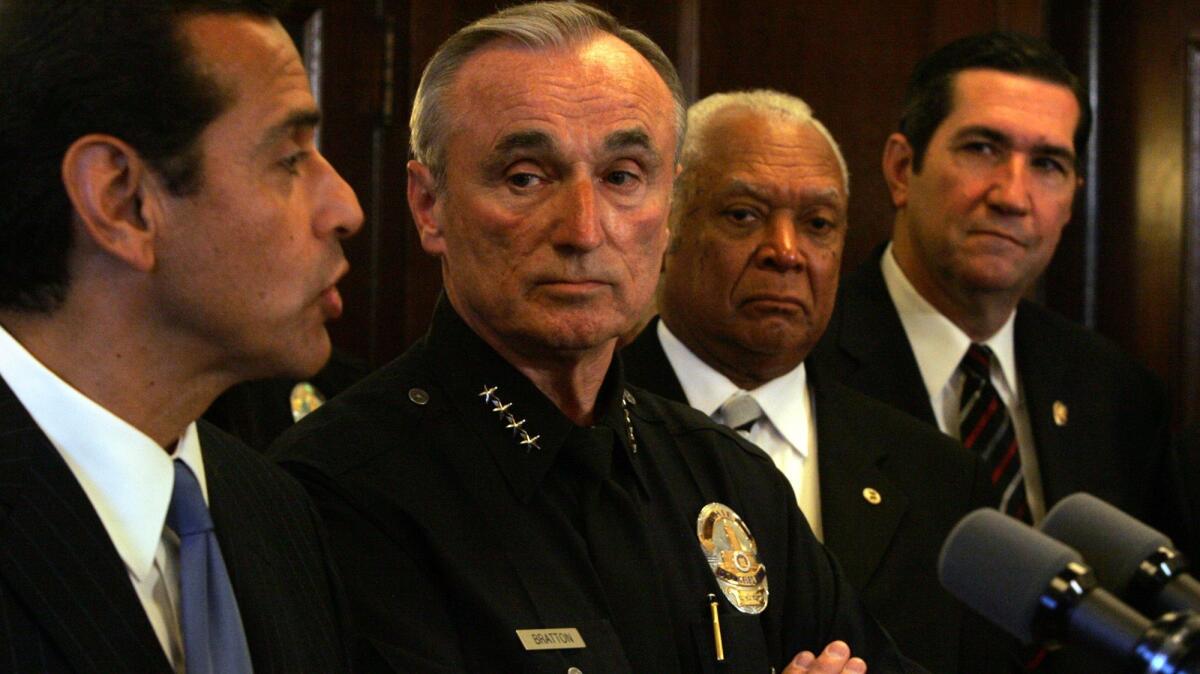
The report and a legal settlement that Sobel helped negotiate, which included court-mandated reforms to how the department policed crowds, marked a turning point. Nearly all of the more than 9,000 officers in the department were retrained in crowd-control tactics.
And, in advance of more demonstrations, hundreds of officers were put through role-playing exercises to practice quickly extracting violent protesters from an otherwise peaceful group.
“Is everyone clear on chain of command?” Michael Hillmann, a deputy chief in charge of the retraining effort, asked at one training session in 2008. “Everyone clear on who is in charge of what?”
In the years that followed, LAPD avoided major debacles. The chief at the time, Charlie Beck, won praise for his generally patient approach to sometimes tense situations, including in 2011 when he waited weeks before breaking up an encampment of protesters on the City Hall lawn and did it without any force being needed.
Sobel, who is involved in current lawsuits against the department, looks back on that period with mixed feelings. “Absolutely, there was progress,” she said, “but there were also opportunities lost.”
Those missed chances, she said, revolved around LAPD’s refusal to quickly cite and release people detained for violating an order to disperse or some other nonviolent violation. Instead, the LAPD has persisted in arresting protesters, often holding them for hours.
For example, after a police officer shot and killed Michael Brown in Ferguson, Mo., in 2014, the LAPD refrained from widespread uses of force, but arrested more than 320 people, considerably more than in other cities. The trend continued during protests over President Trump’s 2016 election and inauguration.
Sobel said she has been trying for years without success to get department leaders to see that the practice infringes on people’s constitutional right to protest.
Before Trump’s inauguration, the current LAPD chief, Michel Moore, acknowledged the heavy reliance on arrests and defended the practice, saying it is a necessary response to unlawfulness.
Moore and his commanders didn’t shift from this stance when protests over the Floyd killing and police killings of Black people erupted late last month. Nearly 2,500 people have been arrested for violating curfews or failing to disperse.
Those arrested recounted how police surrounded and arrested them with no notice, sometimes before curfews began, and cuffed their hands with plastic zip ties that dug into their skin.
Many were bused to a UCLA sports stadium and other processing sites where they were held in custody for up to 12 hours before being released far from their homes in the early-morning hours.
Beyond the arrests of peaceful protesters, LAPD officers brought a level of force to the first days of the protests that had not been seen in Los Angeles since the MacArthur Park melee in 2007.
In one widely viewed video, officers are seen using batons to forcibly strike marchers who appear to pose no threat. Others show officers firing foam projectiles at protesters. Dozens of people have filed complaints with the LAPD over officers’ behavior during the protests, with at least 28 people alleging that officers used excessive force.
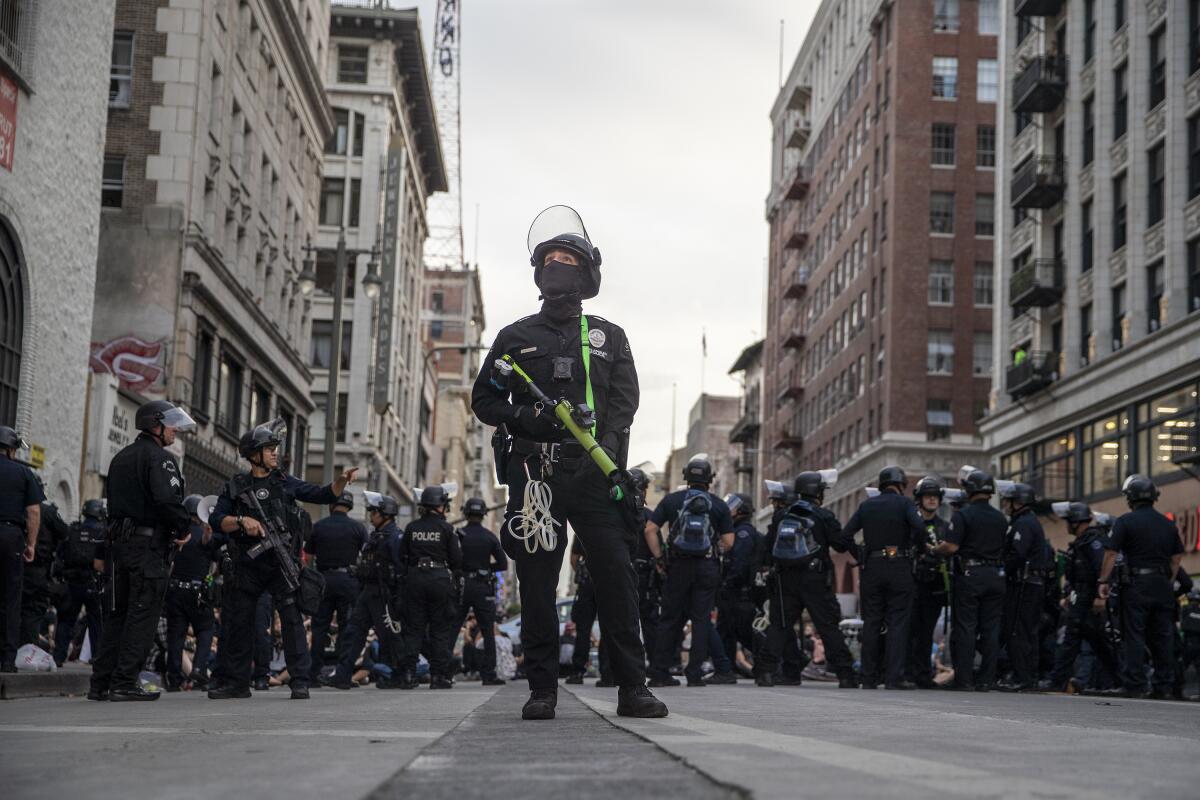
LAPD Assistant Chief Robert Arcos said in an interview that commanders in the field and senior officials directing the department’s response went into the protests wanting to disperse crowds methodically and without force, but had to escalate their response when they encountered people throwing hard objects at officers, burning cars and stealing from businesses.
“We wanted to help facilitate [the protests] and wanted to help get them to where they want to go. We didn’t want to get in the way,” Arcos said. “There was a number of groups in there that had nothing but the intent to protest peacefully ... But they were embedded with other folks who had different ideas. Their whole intent was to create chaos. Then really we have to switch very quickly from crowd management to crowd control.”
Protesters have challenged that view, saying police instigated crowds by amassing in riot gear and penning people into confined areas with no escape.
The LAPD’s methods eased noticeably as marches went on throughout the week. By the second weekend of unrest, thousands of protesters filled Hollywood Boulevard without a cop in sight. Police staged blocks away, but largely left protesters alone. Things remained largely peaceful.
Mayor Eric Garcetti said he will direct $250 million to youth jobs, health initiatives and “peace centers” to heal trauma, and will allow those who have suffered discrimination to collect damages.
Critics say police changed their tactics after coming under scrutiny for their initial response. Arcos and Moore disagreed, saying the shift was possible because protests grew more peaceful and people intent on doing causing problems stopped showing up in large numbers.
As she starts in on yet another legal battle to once again extract settlement payments and reforms from the LAPD, Sobel, the civil rights attorney, plans to change tack. In the past, agreements hammered out in court included expiration dates. Whatever comes out of this debacle, she said, should be permanent.
“We’ve got to get away from this cycle, this history of backsliding over and over again over 30 years,” Sobel said. “Maybe it’s not as bad as it once was, but it’s still not good.”
More to Read
Sign up for Essential California
The most important California stories and recommendations in your inbox every morning.
You may occasionally receive promotional content from the Los Angeles Times.
